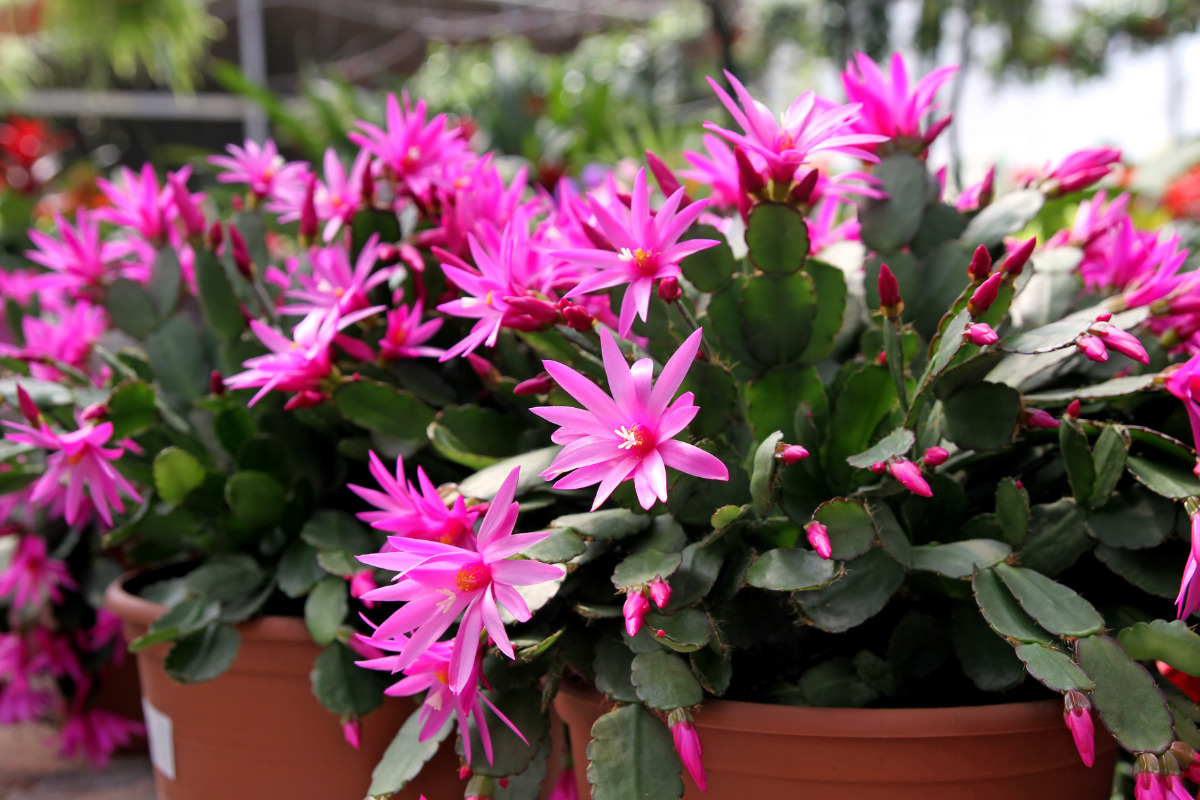
Table of Contents
Easter cactus is a great choice if you’re looking for a spring-flowering holiday plant to grow in your garden. Easter cactus symbolizes rebirth and can also be a great holiday gift. The star-shaped prolific flowers bloom around the time of Easter holidays in colors ranging from purple to red.
Keep reading to find out all about how to grow and care for your Easter cactus and what problems you might need to solve along the way so that your plant can thrive.
About Easter Cactus
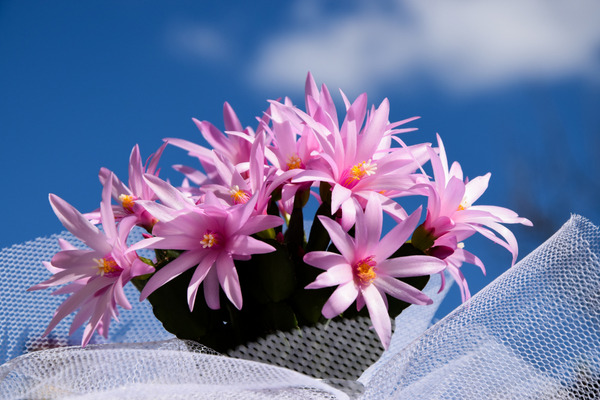
Easter cactus, also known as Rhipsalidopsis gaetneri or Hatiora gaetneri, is a flowering plant native to Brazil. It’s a member of the cactus family and is known for its beautiful, long-lasting blooms that appear in shades of red, pink, purple, or white. The plant is called an Easter cactus because it typically blooms around the Easter holiday, although it can also bloom at other times of the year with proper care.
Native to the Brazilian rainforests, the Easter cactus is composed of segments which are its leaves. The plant was first discovered in the mid-19th century by a German botanist named Karl Hartweg, who brought the plant back to Europe where it quickly gained popularity as a houseplant. In the 20th century, the plant became widely available in the United States and has since become a popular choice for indoor gardens.
Holiday Cacti – Thanksgiving, Easter, Christmas
There are three main types of holiday cacti: Christmas cactus, Thanksgiving cactus, and Easter cactus.
· Christmas Cactus
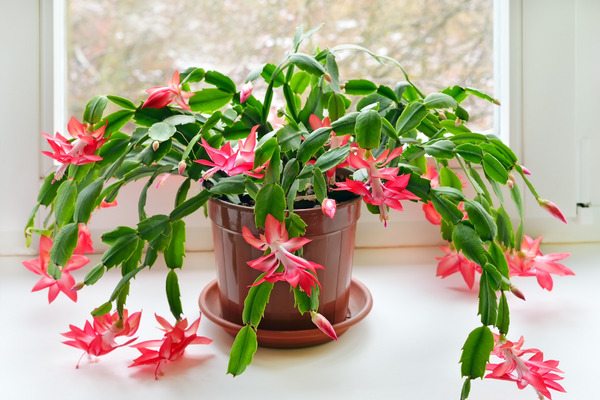
Christmas cactus (Schlumbergera x buckleyi) is a tropical plant native to Brazil that is often grown as a houseplant. It has flattened stem segments with leaf-like paddles and flowers that are typically red, pink, or white. Christmas cactus is known for blooming around the holiday season, hence its name.
· Thanksgiving Cactus
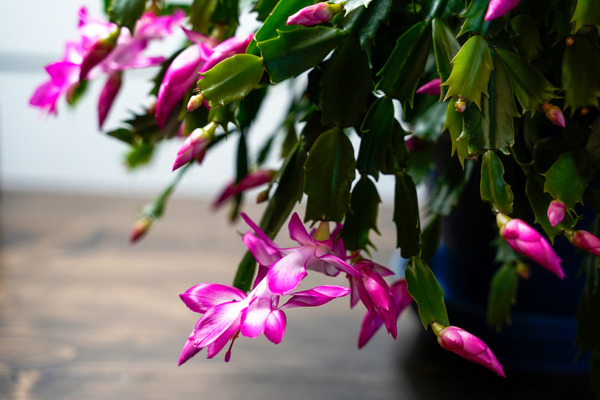
Thanksgiving cactus (Schlumbergera truncata) is also native to Brazil and is closely related to the Christmas cactus. It’s distinguished by its more pointed stem segments and red, pink, or purple flowers. Thanksgiving cactus tends to bloom a little earlier than Christmas cactus, around late November or early December.
· Easter Cactus
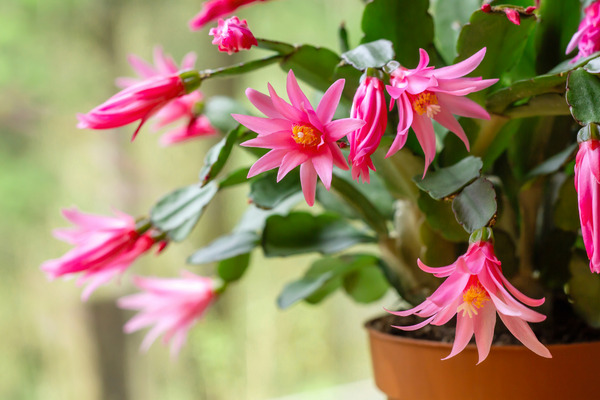
Easter cactus (Rhipsalidopsis gaertneri) is native to South America and is known for its bright, star-shaped flowers that bloom in shades of red, pink, or white. It’s called an Easter cactus because it typically blooms around the Easter holiday. Easter cactus has flattened stem segments with rounded edges and small spines.
All three of these holiday cacti are popular as houseplants because of their attractive flowers and easy care. They prefer bright, indirect light and well-draining soil, and they should be watered only when the soil is dry to the touch.
These cacti also require a period of cooler temperatures and shorter days in order to bloom, so they may need to be placed in a cooler location for a few weeks before they are expected to flower.
Growing and Caring for Easter Cactus
Here are some important things to consider when growing your very own Easter cactus:
Sunlight
Easter cactus grows best in bright, indirect light. It can tolerate some direct sun but should be protected from intense, direct sunlight, which can cause the plant to become stressed and may result in scorched or faded leaves. Too little light can also prevent the plant from blooming.
Ideally, an Easter cactus should be placed in a location where it receives bright, indirect light for most of the day. This can be achieved by placing the plant near an east- or west-facing window, or by using a sheer curtain or blind to filter the sunlight. It’s also a good idea to rotate the plant occasionally to ensure that all sides of the plant receive an equal amount of light.
In general, it’s important to pay attention to the specific light requirements of any plant and to provide it with the appropriate amount and intensity of light for optimal growth and flowering. If you’re not sure whether a particular location is suitable for an Easter cactus, you can use a light meter or simply observe the plant to see how it is doing.
Water
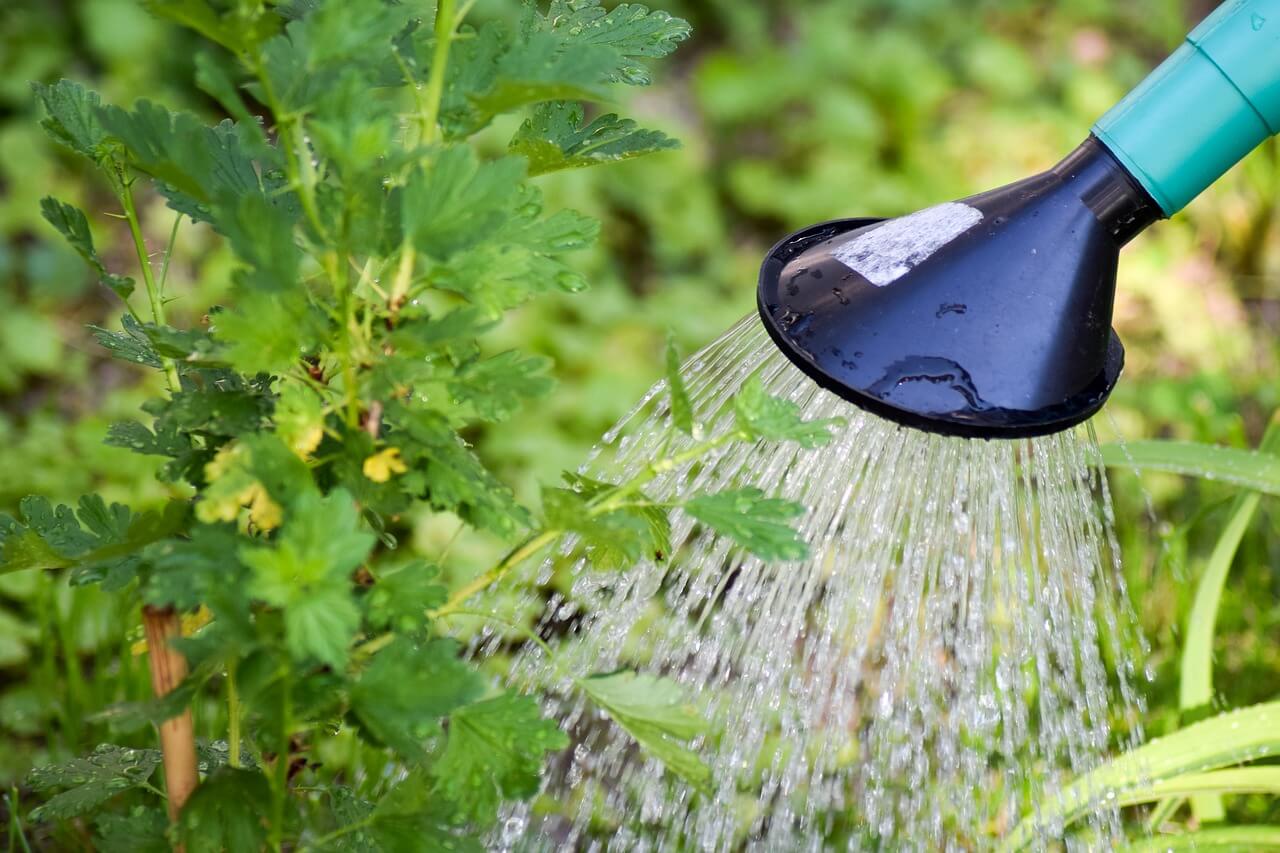
Easter cactus is a relatively drought-tolerant plant that requires regular watering to stay healthy. The specific watering needs of an Easter cactus will depend on factors such as the plant’s size, age, and the humidity and temperature of its environment. In general, it’s important to allow the soil to dry out slightly between watering to prevent over-watering, which can lead to root rot.
To check the moisture level of the soil, you can use a moisture meter or simply insert your finger about an inch into the soil. If it feels dry at that depth, it’s time to water the plant. It’s also a good idea to avoid letting the plant sit in standing water.
It’s always better to underwater an Easter cactus than to overwater it, as the plant is more sensitive to excess moisture than to drought. If you’re unsure about how much to water your Easter cactus, it’s a good idea to check the soil regularly and water the plant as needed.
Soil
Easter cactus grows best in well-draining soil that’s slightly acidic, with a pH between 5.5 and 6.5. A good potting mix for Easter cactus should be light and porous, allowing excess water to drain away easily. A commercial cactus or succulent soil mix is a good choice, or you can make your own by mixing equal parts potting soil, perlite, and coarse sand.
It’s also a good idea to add a small amount of compost or organic matter to the soil to provide additional nutrients for the plant. In general, it’s important to use a soil mix that’s well-aerated and drains well to prevent root rot and other problems.
Fertilizing

Easter cactus doesn’t require a lot of fertilization to stay healthy. In fact, over-fertilization can lead to excessive growth and reduced flowering. A balanced, all-purpose fertilizer that is formulated for cacti and succulents is generally sufficient to meet the plant’s needs.
It’s generally recommended to fertilize Easter cactus once a month during the growing season (spring through fall) using a dilute solution of fertilizer at half the recommended strength. It’s best to fertilize the plant when it is actively growing and producing new leaves and flowers.
It’s also a good idea to reduce or stop fertilizing the plant during the winter months when it’s not actively growing. Over-fertilizing an Easter cactus can lead to excess foliage and reduced flowering, so it’s important to use fertilizers sparingly and follow the recommended dosage instructions.
Humidity and Temperature
Easter cacti are native to the humid rainforests of Brazil. Unlike ordinary cactus, the Easter cactus prefers cooler climates. When grown indoors, they can thrive in areas with some moisture.
When the nighttime temperatures are between 55 and 60 F, the Easter cactus blooms. During the dry season or if your indoor environment is dry, it is a good idea to make the place humid by using a pebble tray or a humidifier.
Pruning
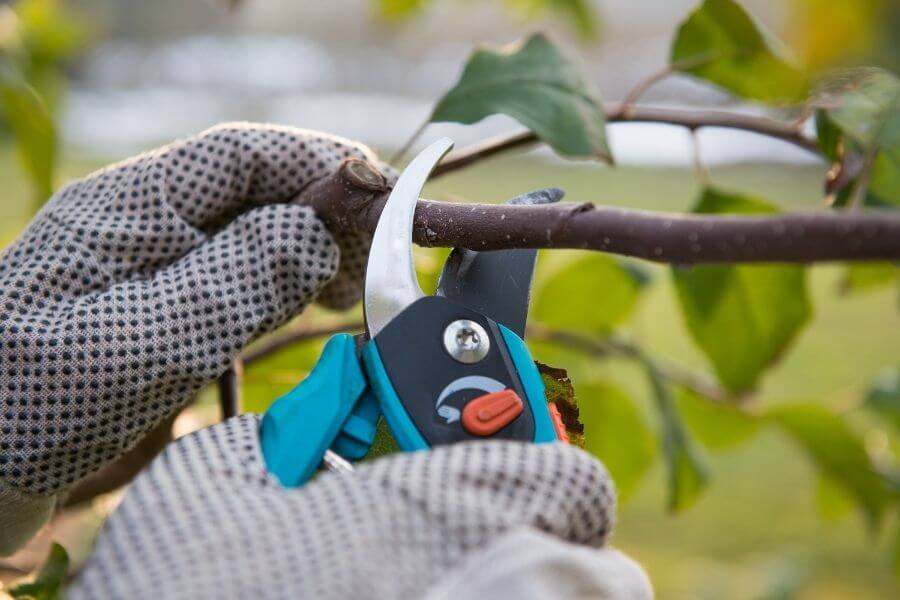
To prune an Easter cactus, use clean, sharp scissors or pruning shears to remove any dead, damaged, or diseased stems or leaves. It’s generally best to prune the plant in the spring or early summer when it’s actively growing.
Avoid removing more than a third of the plant’s growth at one time, as this can stress the plant and reduce its ability to recover. Pruning can help to encourage the plant to produce new growth and can help to maintain its overall shape and appearance.
Easter Cactus Propagation
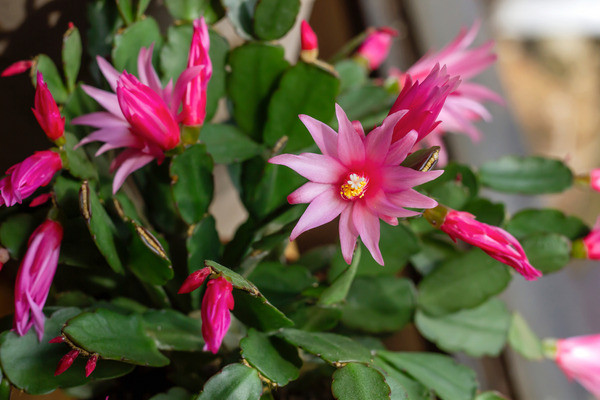
Easter cacti can be propagated from seeds or from cuttings.
Propagating from Cuttings
- Cuttings are the most popular and much easier way to grow Easter cacti.
- Use a disinfected knife when cutting. Cut a 10 cm long shoot from your Easter cactus
- Dry the shoot for up to 3 days. A 2-part potting soil to 1 part quarts sand makes a good substrate to plant the shoot, placing the dried cut end into the substrate. Roots tend to form in about 2 weeks.
- Lightly mist the leaves.
- To keep the moisture locked inside, place plastic bags on top of the cuttings.
- You may see roots sprouting out of the leaf in a few weeks. Mist the sprouts and once they are strong saplings, repot it.
- Start watering and caring for the plant as you would do for a mature Easter cactus.
Propagating from Seeds
- To produce seeds, Easter cacti can be pollinated by hand using a small brush. This is done by dabbing the pollen from one variety of Easter cactus bloom to the stigma of another Easter cactus variety.
- Once your Easter cactus bears fruit, break open a fully ripe fruit gently with your fingers.
- Spread the fruit on a paper towel and let dry
- Separate the seeds from the fruit pulp by gently touching the seeds with a moistened finger (seeds tend to stick to moisture), then brush off the seeds onto a separate sheet of paper towel.
- Place the paper towel of seeds over potting mix in a flat tray.
- Water the seeds that are on the paper towel so that there is enough moisture.
- Once the seedlings look strong enough, repot them.
Potting and Repotting
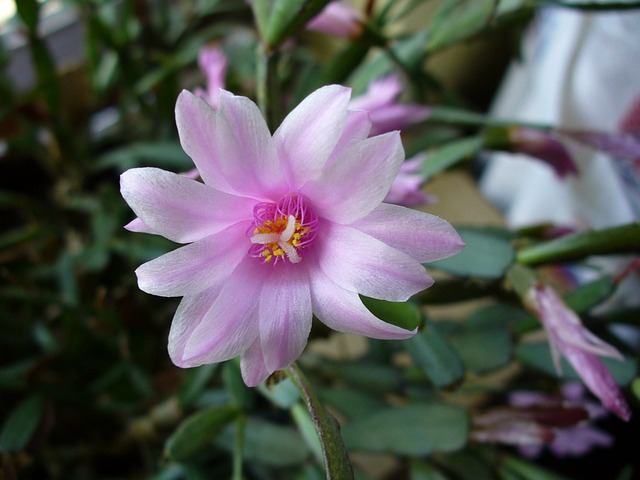
You may need to repot Easter cactus every two years to refresh the soil. Otherwise, it enjoys being pot-bound and snug. If the current pot is big enough for the growing plant, then just change the potting mix and plant it back in the same pot.
If you need to resize the pot, then the best container to choose is 2 to 3 inches wider than the previous one. Easter cactus grows well in clay pots as they offer drainage and aeration. The best time to repot it is after the blooming phase in the spring.
Pests and Diseases of Easter Cactus
Like all plants, Easter cactus is susceptible to a range of pests and diseases. Some common pests that can affect Easter cactus include mealybugs, aphids, scale insects, and spider mites. These pests can cause damage to the plant by sucking the sap from the leaves and stems, which can lead to stunted growth and reduced flowering.
To control pests on Easter cactus, use organic methods such as introducing natural predators, removing infected parts of the plant, or applying horticultural oils or soaps. Chemical pesticides can also be used, but it’s important to follow the label instructions carefully and to choose a product that’s specifically formulated for use on cacti and succulents.
Easter cactus can also be prone to diseases such as root rot, which is caused by overwatering or poor drainage. To prevent root rot, it’s important to provide the plant with well-draining soil and to water it only when the soil is dry to the touch.
Other diseases that can affect Easter cactus include fungal infections and viral diseases, which can cause yellowing or distortion of the leaves, or reduced flowering. To prevent these diseases, it’s important to keep the plant healthy and to avoid over-watering or over-fertilizing it.
How to Boost Flowering
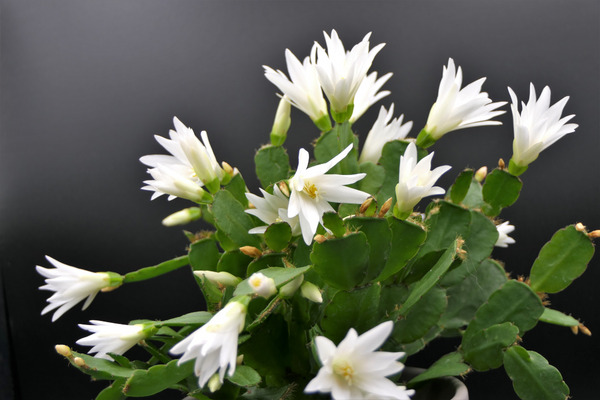
Easter cacti are grown for their gorgeous star-shaped flowers. If provided with the right care, Easter cacti could continue to bloom on the same plant every season for more than a decade. The usual time for Easter cactus to bloom starts in late winter and ends in early spring. But before blooming, these plants need cool temperatures and long nights.
It’s a good idea to slow the fertilizing before the plant starts to bloom. Remember to provide equal amounts of indirect light and darkness. Never put the plant close to a heating source such as a heater but keep it warm and in light during the day. Allow the plant to remain at about 50 F, and a cool temperature during the nights. Keeping the plant warm ensures that the blooming period starts early.
Once your Easter cactus has completed blooming, it is important to feed the plant and get it ready for its next season of blooms. Do this by cutting back on the watering and providing the right temperature and light needs. These conditions ensure that the plant starts blooming prolifically in early spring.
Easter Cactus Problems
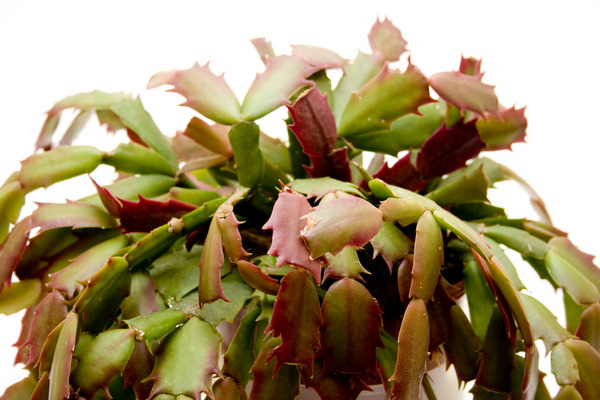
Although Easter cactus is a low-maintenance plant, there are common problems that will affect the plant.
- Too much sunlight: Just move the plant to where it receives less sunlight.
- Overwatering: You could see rotted roots. Just repot the plant after cutting the affected roots using sterile scissors.
- Underwatering: start to water it regularly, starting with small amounts in the beginning.
The common problems with Easter cactus include the following:
- Wilting: Easter cactus can have wilting leaves if the plant is underwatered, overwatered, or getting excess direct sunlight.
- Drooping Leaves: When leaves start to droop and fall off, the whole plant seems stressed. Overwatering and underwatering can both be the reason behind drooping leaves. Just adjust the watering schedule and plant the fallen pads in potting soil and new plants will grow out of them.
- Yellowing leaves: Not having sufficient drainage can result in leaves turning yellow. Check for root rot and repot the plant in soil that offers proper drainage.
Interesting Facts about the Easter Cactus
Here are a few interesting facts about Easter cacti:
- Easter cactus is native to South America, where it grows as an epiphyte (a plant that grows on other plants) in the canopy of rainforests.
- It’s closely related to the Christmas cactus and Thanksgiving cactus, which are also popular holiday plants.
- The Easter cactus is a relatively easy plant to grow, and it’s popular as a houseplant because of its attractive flowers and low maintenance requirements.
- To encourage an Easter cactus to bloom, it’s important to provide the plant with plenty of bright, indirect light and to follow a regular watering schedule.
- Easter cactus can be propagated by rooting stem cuttings or by dividing the plant when it becomes overcrowded.
- Easter cactus is a popular gift plant for the Easter holiday, hence its name.
Wrapping Up
If you think you should include Easter cactus in your home or garden, start planning to grow your own Easter cactus before spring is around the corner. The plants should get some time to adjust and start blooming. With the right care, you will be able to enjoy growing this beautiful plant and add a splash of color to your garden.
Easter Cactus FAQs
Easter cactus is not considered a rare plant. It is widely available and can be found at garden centers and plant stores.
Easter cactus typically blooms once a year, usually around the time of Easter. However, with proper care and conditions, it is possible for Easter cactus to bloom more than once a year.
Repotting every 2-3 years is sufficient for Easter cactus.
Easter cactus naturally produces purple pigments in its stems and flowers, so it is not uncommon for the plant to have some purple coloration. However, if your Easter cactus is turning purple unexpectedly, it could be due to stress, such as exposure to extreme temperatures or inadequate watering. It can also be caused by a fungal or bacterial infection, or by the presence of excess aluminum or manganese in the soil.
Epsom salt, which is a type of magnesium sulfate, can be beneficial for Easter cactus and other types of cactus and succulent plants.






